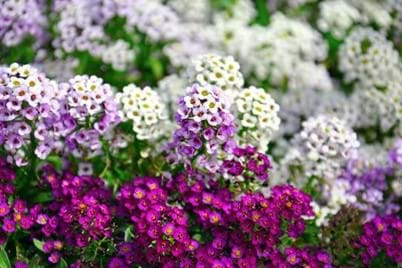Flowering Plants
When you're looking for a flowering, low growing filler plant for garden beds and pots, pretty little alyssum is a common choice. It may not usually take centre stage and is often taken for granted, however alyssum is a very worthy plant to grow and makes a gorgeous border plant even when grown on its own.

Yates® Alyssum 'Carpet of Snow' is a long lasting and hardy annual that is smothered in masses of tiny honey scented white flowers and Yates Alyssum 'Cameo Mixture' has a blend of beautiful white, cream and violet flowers
Both these Yates alyssum varieties grow to a petite 10 cm tall and will start flowering from 2 months after sowing.
In warm and temperate zones during June it's as easy as scattering seed direct where they are to grow and only just covering with 2 mm of loose soil or Yates Seed Raising Mix. Firm down and keep the soil moist while the seeds germinate (which takes around 2 weeks) and the seedlings establish. In cool zones look for seedlings of alyssum in your local garden centre or delay sowing seed until spring.
Here are some beautiful flower combinations using alyssum:
- Plant mauve, white and pink violas together with alyssum in a trough or window box to create a compact and lovely pastel display.
- Combine lemon yellow trailing pansies with alyssum in a hanging basket. The pansies will spill beautifully over the basket edge and the alyssum adds a soft fullness.
- In a garden bed or large pot, plant purple salvias at the rear and a swathe of alyssum at the front. Too pretty!
- Plant white, purple and pink alyssum varieties together for a mass of colour.
Protect seedlings from damaging snails and slugs with a light sprinkling of Yates Blitzem® Snail & Slug Pellets and then feed the alyssum plants every week with Yates Thrive® Roses & Flowers Liquid Plant Food. It will encourage strong healthy plants and lots of beautiful little flowers. Trim the plants back regularly to help keep them tidy and encourage new growth and flowers.
Did you know? Alyssum attracts bees and other beneficial insects into the garden, so it's pretty and clever too!
Grow a charmer
You can add gorgeous winter colour into low light areas in your garden with hellebores. Also known as 'winter roses', they are perfect for growing in full to partly shaded spots such as underneath the canopies of trees or in a pot on a shady patio. They are a delight during the cooler months of the year, putting on a prolific display of large, bell shaped flowers right throughout winter and into early spring.

Hellebore 'Charmer' (pictured above) is a spectacular hellebore from Plant Growers Australia. It has masses of delicately mottled burgundy-red flowers that sit neatly above the lush green foliage. Growing to around 30 cm high and 50 cm wide, it has a smaller and more compact habit than other hellebores.
'Charmer' will flower for many months and looks wonderful when massed planted in a shady garden bed or grown in a decorative container and displayed in a sheltered outdoor entertaining area. You can even bring potted Charmer indoors for a few days at a time to show off their flowers.
Trim off spent flower stems to keep plants looking tidy and promote further flowers. Hellebores will benefit from applications of Yates® Thrive® Natural Roses & Flowers Organic Based Pelletised Plant Food around the root zone every 6-8 weeks, of both in-ground and potted plants. Yates® Thrive® Natural Roses & Flowers Organic Based Pelletised Plant Food contains a special combination of more than 50% natural ingredients, boosted with fast acting fertilisers, including flower-promoting potassium, to encourage both vigorous green leaf growth and lots of cool season flowers.
For more details on Hellebore 'Charmer', visit Plant Growers Australia.








